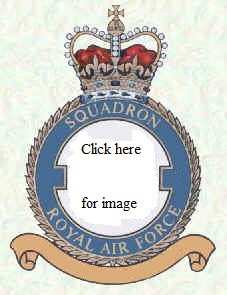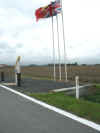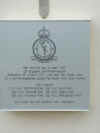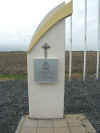Air
of Authority - A History of RAF Organisation
No 156 - 160 Squadron Histories
No 156 Squadron
.
 |
On
9 May 1918, it was proposed to form the squadron for deployment to France with
DH9As in September and then October but these plans were cancelled on 4 July.
Its formation was immediately rescheduled to form on 12 September for deployment
on 12 November, but this plan was suspended on 29 July. It was eventually
formed on 12 October 1918, from elements of Nos 27, 35, 52 and 53 Training Depot
Squadrons at Wyton. It received some
DH9As but having failed to achieve operational status was disbanded on 9 December.
The reformed on 14 February 1942 as a Wellington unit in No 3 Group from a
nucleus provided by No 40 Squadron at Alconbury. In August 1942, it was
selected as No 3 Group's contribution to the newly formed Pathfinder Force and
moved to Warboys. It continued to operate Wellingtons in its new role
until January 1943, when it converted to Lancasters. The squadron
maintained it's role as a target marking squadron until the end of the war,
moving to Upwood in March 1944 and Wyton in June 1945, where it disbanded on 25
September 1945. |
Squadron Codes used: -
| TB |
Allocated Apr 1939 - Sep 1939 |
| GT |
Feb 1942 - Sep 1945 |
| XY |
Allocated to 'C' Flight |
[Aircraft & Markings |
Commanding Officers]
No 157 Squadron
 |
On
9 May 1918, it was proposed to form the squadron for deployment to France with
Snipes in August but by the end of May these plans had been cancelled. It
was then proposed to make it the first Salamander equipped unit, again for
deployment in August, but on 4 July these plans were also cancelled.
Its formation was immediately rescheduled to form on 14 July, again with
Salamanders, for deployment
on 14 September, but equipment shortages led to its deployment being put back to
14 October and then 14 November. It was fully equipped by 11 November with
a revised deployed date of 21 November, but the Armistice, resulted in the
cancellation of this and the squadron disbanded on 1 February 1919.
The squadron reformed at Debden on 13 December 1941, before
moving to Castle Camps four days later. It was January 1942 before it
received its equipment of Mosquito night fighters, becoming the first RAF night
fighter equipped with this excellent aircraft. Following a lengthy work
up, the squadron became operational on 27 April. Operating in the East
Anglian area, it received some Mosquito VIs in July 1943, which it used to begin
intruder operations as well as its usual night interception duties.
In November 1943, it moved to Predannack, from where it continued with both of
these roles but in March 1944 it reverted to the purely defensive role when it
moved to Valley. However, a further change of role and parent unit came in
May 1944, when it joined No 100 (Bomber Support) Group at Swannington. It
was now supporting Bomber Command operations by carrying out intruder missions
against German night fighter bases and flying within the bomber stream to attack
enemy night fighters attempting to intercept the bombers. The squadron
disbanded on 16 August 1945. |
Squadron Codes used: -
| VW |
Allocated Apr 1939 - Sep 1939 |
| RS |
Dec 1941 - Aug 1945 |
[Aircraft & Markings |
Commanding Officers]
No 158 Squadron
 |
On 9 May 1918, it was proposed to form the squadron for deployment to France
with Snipes in early September. Its equipment was then changed to Salamanders
with a revised deployment date of late September, but these plans were cancelled
on 4 July. Its formation was immediately rescheduled to take place on 14 August
for deployment in October, but this plan was suspended on 29 July. It
eventually formed as a Salamander squadron at Upper Heyford on 4 September 1918,
from elements of the Nos 42, 50 and 53 Training Depot Squadrons and the Central
Flying School. It is unlikely to have received any operational aircraft by the Armistice and it
disbanded on 20 November 1918.
squadron reformed on 14 February 1942 at Driffield from a nucleus provided by
No 104 Squadron, equipped with Wellingtons until June when Halifaxes arrived.
At the same time the squadron moved to a new home at East Moor and then in
November to Rufforth. In February 1943, the squadron moved to what would be its
main wartime home of Lissett, from which it operated as part of Bomber Command's
Main Force for the remainder of the war. Halifax III aircraft arrived in
January 1944 and at the same time 'C' Flight was used to provide the basis of No
640 Squadron, which immediately moved to Leconfield. After the war, the
squadron together with the rest of No 4 Group, was transferred to Transport
Command and began receiving Stirlings in June. These were taken to Stradishall
in August, from where it conducted trooping flights to the Middle East and India
until disbanding on 31 December 1945.
One of No 158's Halifax IIIs, LV907 named 'Friday the 13th' ended the war having
completed 128 operational missions and after the war was displayed in London,
but unfortunately only the nose panel with its distinctive nose art and mission
markings was saved and is now housed in the RAF Museum at Hendon. However, the
aircraft has been recreated by the Yorkshire Air Museum at Elvington from
various Halifax and Hastings components and newly built items.
|
Squadron Codes used: -
| HT |
Allocated Apr 1939 - Sep 1939 |
| NP |
Apr 1942 - Jun 1945 |
[Aircraft & Markings |
Commanding Officers]
No 159 Squadron
 |
On
9 May 1918, it was proposed to form the squadron for deployment to France as a
fighter unit in September, equipped with either Dolphins or SE5As but by the end
of the month these plans were cancelled and the squadron never formed during
World War One. The history of this unit in World War Two is
somewhat confused but it began to form on 2 January 1942 at Molesworth as a
Liberator equipped bomber unit destined for the Middle East. The ground
personnel left by sea in February 1942 and arrived in Egypt in April, in the
meantime the air element was still in the UK training. In May most of the
ground staff were sent to India and it was June before the air element began its
journey and on arrival it absorbed the aircrew of No 160 Squadron. In July
this joint unit moved to Palestine, its aircraft now being serviced by
personnel of Nos 458 and then 454 RAAF squadrons. Finally in September the
No 159 element continued on to India and the element left in the Middle East
adopted the identity of No 160 Squadron. Arriving at Salbani in
late September the squadron was finally ready to begin operations against the
Japanese in November. Long range bombing operations then became the order
of the day until the end of the war, with targets being located in Burma,
Malaya, Siam and even the Dutch East Indies. With the war over, the
squadron transferred to transport duties until disbanding on 1 June 1946. |
Squadron Codes used: -
| NS |
Allocated Apr 1939 - Sep 1939 |
[Aircraft & Markings |
Commanding Officers]
No 160 Squadron
 |
On
9 May 1918, it was proposed to form the squadron for deployment to France with
DH9As in early October, soon amended to late October but these plans were cancelled on 4 July.
Its formation was immediately rescheduled to form on 20 September for deployment
on 20 November, but this plan was suspended on 29 July and then on 17 August,
cancelled. The squadron never formed during World War One. Like No 159, the history of this unit in World War Two is somewhat confused but
it began to form on 16 January 1942 at Thurleigh as a Liberator equipped general
reconnaissance unit destined for the Far East. The ground personnel left
by sea in February 1942 and arrived in India in June, in the meantime the air
element was still in the UK training at Polebrook. It was June before the
air element began its journey and on arrival in the Middle East, whilst
en-route, it was absorbed by No 159 Squadron. In July this joint unit
moved to Palestine, its aircraft now being serviced by personnel of Nos 458 and
then 454 RAAF squadrons. Finally in September the No 159 element continued
on to India and the element left in the Middle East adopted the identity of No
160 Squadron. From November aircraft began moving to India, those left in
the Middle East continuing its operations until 15 January 1943 when it was
amalgamated with No 147 Squadron to form No 178 Squadron. As more
aircraft and crews joined the original No 160 ground personnel in India it began
to reform as a general reconnaissance unit beginning operations over the Bay of
Bengal on 6 February 1943. The squadron was also soon carrying out
long-range photo-reconnaissance missions over Sumatra and other Japanese held
territory as well as minelaying and from June 1945 it began supply dropping
operations. After the war, it transferred to transport operations,
operating from India to Ceylon and Malaya, these ending in June 1946. The
squadron returned to Leuchars, where it had its establishment reduced to six
aircraft. Continuing in the general reconnaissance role its
Liberators were replaced by Lancasters in August but on 30 September 1946 it was
disbanded by being renumbered No 120 Squadron. |
Squadron Codes used: -
| JJ |
Allocated Apr 1939 - Sep 1939 |
| BS |
Dec 1944 - Oct 1946 |
[Aircraft & Markings |
Commanding Officers]
Squadron badge image on this page is courtesy of Steve
Clements
© Crown Copyright is reproduced with the permission of the Directorate of
Intellectual Property Rights
This page was last updated on
17/03/25©
 Organisational Index
[Top of
Page]
Sqns 161 - 165
Organisational Index
[Top of
Page]
Sqns 161 - 165




![]() Organisational Index
Organisational Index ![]()